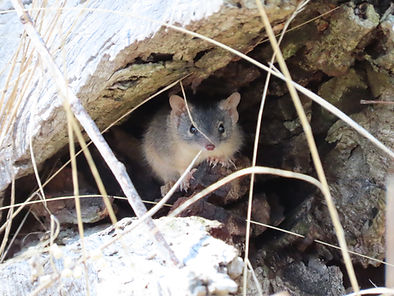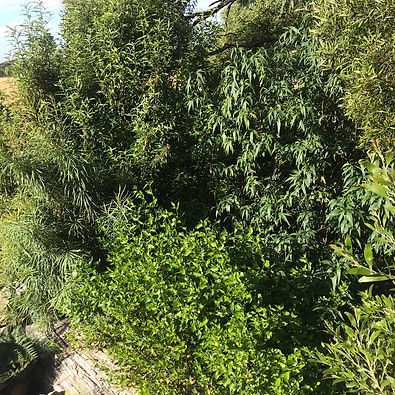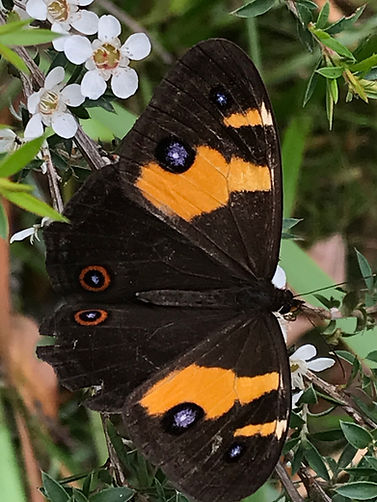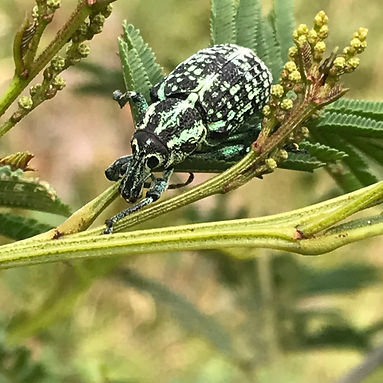4. Gardening for Biodiversity
Because of the complex relationships or connections we find in nature (topic 1), small changes within ecosystems can have cascading effects. This can be an alarming realization when contemplating the extinction of species within an ecosystem: each extinction impacting or destabilising other species, causing an accelerating simplification or collaps. However, to some degree the opposite can also be observed. When we start replacing habitat and species within a modified landscape, we can witness a rapid increase in biodiversity. This is what makes gardening for biodiversity (or habitat gardens or gardening for wildlife or pollinator gardens) so exciting. Within a short period of time we can begin to appreciate the beneficial impact we are having on the life around us.
Increasing the ability of a garden to attract and support a greater diversity of fauna can be as easy as adding water. Dishes of water placed at varying heights will support all manner of fauna from lizards and frogs through to bees and birds. For the more enthusiastic gardener, bird baths, frog bogs or even ponds can be considered. Sticks can be used as ramps, to prevent smaller creatures from becoming stuck within water. Placing water adjacent nearby cover (e.g. shrubs, grasses etc.) will provide terrestrial fauna with a quick escape route, whilst raising bird baths up high can be beneficial where there are roaming cats.
Logs are habitat for fungi, invertebrates, reptiles and the like and are often utilised as walkways by mammals such as possums. Rocks are similarly well utilised, being a basking place for reptiles or shelter for numerous invertebrates (lift a rock and you'll often find numerous species co-inhabiting beneath).
Leaf litter is important to everything from microorganisms in the soil, through to birds constructing nests, and helps retain moisture for plants. The addition of an arborist / tree mulch containing wood, bark and leaf material can be a good method of replicating litter and will add extra organic matter to soil in the medium term.
Bat boxes, small mammal boxes and bird boxes can be bought or made if you have the resources to maintain them. If installed, it is best to keep at a height where they can be safely reached for maintenance or to remove any unwanted pest species.
PLANNING
There are many things to consider when planning any garden. The size of the area, soil type and moisture availability, access requirements, fire risk, infrastructure etc.
Once you have a plan or have at least a loose idea about what you want to achieve and avoid, there are some general do's and don't when gardening to increase biodiversity.
-
Dense vegetation, overhanging branches, abundant leaf litter and a little mess in general, is good. Try not to be too voracious with the rake and snippers (obviously fuel reduction needs to be considered in rural locales).
-
Planting an abundance of large-flowered nectar rich species such as Banksias and Grevilleas can result in large honeyeaters (e.g. Wattlebirds and Noisy Miners) becoming possessive and dominant within the garden. Avoid planting these plant types en masse and stick with your locally occurring species rather than large-flowered cultivars.
-
Dense patches of small shrubs and large grasses and sedges, can provide protection and nesting sites for small birds. Clusters of prickly shrubs are also useful for this purpose.
-
Indigenous plants have been a part of your local area for thousands of years and will typically provide for the greatest suite of local fauna species. Looking at your nearest patches of remnant vegetation or bushland should give you some ideas on species selection.
AN ABBREVIATED LIST
When planting out your garden, diversity is great. A wider range of species throughout the garden will to an extent provide for a wider variety of fauna. Grouping several individuals of the one plant species together in clusters is a good way to go, as this allows fauna to more easily find and use the plants, moving from one individual to another. For some inspiration, here are some ideas on indigenous plants that are known for their important place in our local ecosystems, particularly relating to supporting fauna.
1. MYRTACEAE
Myrtaceae is a plant family containing iconic Australian plants such as gum trees (eucalyptus spp.), tea tree (Leptospermum spp.), paperbark / honey-myrtle (Melaleuca spp.) and bottle brush (Callistemon spp.). Plants in the Myrtaceae family are incredibly important for insects and other nectar feeders and are central plants within most Australian forests and heathlands. Where adequate space is available, planting a local eucalypt species will arguably provide more for biodiversity than any other plant group. Better still, multiple species of eucalypt will provide extended flowering / nectar-production periods. Leptospermum, Melaleuca and Callistemon species are also incredibly attractive to many pollinators and have intimate associations with many insect species. These genera tend to be small to medium shrubs so their inclusion in the average garden is more realistic than the typically large eucalypts. Most Myrtaceae tend to contain volatile oils, so mass planting of these species should be weighed against fire risk. Lilly Pilly Syzygium sp. are in the Myrtaceae family, are attractive to native pollinators and are resistant to ignition in wildfire situations. Lilly Pilly do not naturally occur in the Central Highlands region, and are sensitive to frost, so require shelter (e.g. established trees) to thrive, as well as reliable moisture.
2. ASTERACEAE
The Asteraceae or daisy family is an incredibly diverse group, including over 1000 native Australian species. The family encompasses everything from tiny herbaceous plants through to small trees. Flowers of Asteraceae plants are often very visually appealing to pollinators and reward insect visitors with pollen and sugar -rich nectar. As well as pollinators, many insect larvae also preferentailly feed on the foliage and seeds of Asteraceae species. In the Central Highlands region there are numerous species large and small for moist or dry sites.
-
Olearia glandulosa, Olearia argophylla, Olearia lirata, Olearia erubescens and Olearia myrsinoides (listed in order of moisture requirement wettest to driest) are shrubs with masses of white daisy flowers in the spring-summer. Also utilised by insect larvae.
-
Brachyscome diversifolia is an upright daisy to 50cm which tolerates dry conditions. Brachyscome multifida is a groundcover preferring some moisture. Both are attractive to a variety of pollinators.
-
Everlasting species such as Xerochrysum viscosum, Chrysocephalum semipapposum, Chrysocephalum apiculatum, Helichrysum leucopsideum and Coronidium scorpioides are absolute magnets for pollinators. They are also host to moth larvae and seeds are predated by various invertebrates.
3. PROTEACEA
Like the Myrtaceae, the Proteaceae contain many plants that are emblematic of Australian flora. Banksia, Grevillea, Hakea and Telopea (Waratah) are all members of the Proteaceae family. Proteaceae typically produce copious sweet nectar which is sort after by insects, birds and mammals such as gliders. Species such as Banksia marginata, Hakea decurrens and several Grevillea species are local to the Central Highlands. Hakea decurrens is particularly good habitat, providing nectar for insects and small honeyeaters, woody fruit that are cherished by large parrots and very prickly foliage.
4. FABACEAE
Fabaceae includes both pea-flowering plants (often with egg and bacon type flowers) and Acacias (Wattles).
Acacias big and small are found within nearly all ecosystems within the Central Highlands region and beyond. They are associated with the larval and adult stages of many insects, which in-turn attract insectivorous birds to these plants. Seeds and associated parts are consumed by insects and birds and foliage is browsed by mammals.
Pea-flowering plants are particularly appealing to certain pollinators including native bees, who are particularly adept at successfully pollinating these plants.
There are a diverse suite of small to large Fabaceae species occurring throughout the Central Highlands region. Identifying species local to nearby bushland will be the best indication of what to plant in your garden.
5. POACEAE, CYPERACEAE AND JUNCACEAE
Poaceae, Cyperaceae and Juncaceae, otherwise called grasses, sedges and rushes respectively. Indigenous species within these families are essential for many moth and butterfly species. Birds consume the seed and insects are often abundant within the seed-heads. The tussocks and dense foliage that these plants provide are perfect habitat for ground-dwelling fauna. Foliage is utilised for nesting material by birds and is eaten by herbivores.
The grass, sedge and rush species appropriate to your garden will be dependent on your locality and moisture availability in your landscape.
6. SOME OTHERS
If a plant is indigenous to your local area then it is likely to be beneficial to the local fauna. Some other species of particular note:
-
Bursaria spinosa - Flowers laden with insects in summer, density of foliage and spiny branches make ideal nesting sites.
-
Rutaceae (e.g Correa, Nematolepis and Philotheca) Bell-shaped flowers and nectar production good for small honeyeaters and insects. Typically fire / ignition resistant
-
Lilies -Asphodelaceae and Asparagaceae (e.g. Dianella sp., Arthropodium sp., Bulbine sp.) Attractive to native bees and other pollinators.
-
Allocasuarina spp. (e.g. Allocasuarina littoralis, Allocasuarina verticillata). Small trees that are able to fit within the average garden. Seed from woody fruit food for large parrots.
Many local government areas (including Hepburn Shire and Moorabool Shire) now have Gardens for Wildlife (G4W) groups up and running. These groups provide free information and assistance to help you enhance your existing garden to better support wildlife. Visit: https://gardensforwildlifevictoria.com/ to find out more

Above: Everlastings Xerochrysum sp. are a magnet for pollinators. This orbweaver spider has taken up residence to capitalise on the visiting insects.

Above: Logs provide essential substrate for many fungi, moss, lichen and fern species.
Below: Logs also provide harbour for ground-dwelling fauna. Yellow-footed Antechinus under log in Clunes.


Above: A dense planting of Olearia lirata, Lomatia myricoides, Solanum laciniatum, Goodenia ovata and Acacia melanoxylon, a favoured place for small birds in our garden.

Above: A Swordgrass Brown butterfly feeding on nectar from Leptospermum continentale (family Myrtaceae) in the Wombat Forest

Above: Native bee (Lasioglossum sp.) on Murnong Microseris walteri flower (family Asteraceae)

Above: Hakea decurrens (Family Proteaceae). The seed and nectar provide for various fauna.

Above: Botany Bay Diamond Weevil on Acacia nanodealbata in the Wombat Forest. These beetles feed exclusively on a select group of wattle species.

Above: Red-rumped Parrot feeding on grass seed amongst mixed native and introduced grasses

Above: Fields of Bulbine Lily Bulbine sp. in remnant woodland
